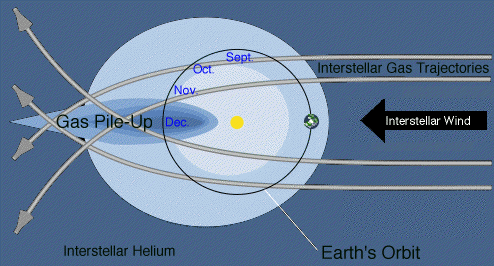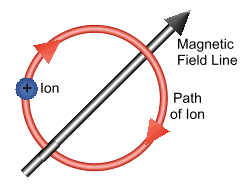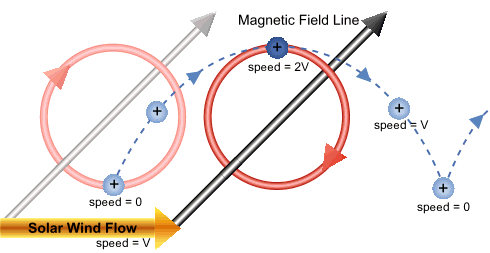The Interstellar Gas Reveals Itself by a "Giant Swing"
or
The first direct touch of the interstellar gas
The time-of-flight mass spectrometer SULEICA on AMPTE IRM was designed to measure charged particles (ions) that are accelerated in and around the Earth's magnetosphere. In 1984, it also detected particles that did not originate in our solar system. This was the first direct measurement of particles from the interstellar gas that surrounds our solar system.
 Our sun is moving through an adjacent interstellar gas cloud in approximately the direction of the constellation Scorpio, with a speed of about 25 km/sec (900 mph). As a result, an interstellar wind with that speed is blowing through our planetary system, like the wind felt while driving an open convertable.
Our sun is moving through an adjacent interstellar gas cloud in approximately the direction of the constellation Scorpio, with a speed of about 25 km/sec (900 mph). As a result, an interstellar wind with that speed is blowing through our planetary system, like the wind felt while driving an open convertable.
Fig. 1: Flow of interstellar helium through the solar system. The gravitation of the sun deflects the flow and piles up the gas on the downwind side. The Earth passes this region in December.
Although the sun sends out a solar wind in all directions, with speeds of 300 - 1000 km/sec (371,000 - 2,237,000 mph!), the interstellar gas is not swept out of our system. Typically, there is 1 atom in each 10 cubic centimeters of interstellar gas, and 10 ions in each cubic centimeter of solar wind near Earth. On average an interstellar gas atom can travel 100 times the distance between Sun and Earth before it is hit by a solar wind particle. Even the magnetic field that is taken along by the solar wind does not help to sweep up the gas due to its fierce UV radiation, as was thought until the late 1960's.
For an animated explanation, download Part I of the movie:

|
| Fig. 2: Gyration of an ion in a magnetic field |
The situation changes as soon as atoms of the interstellar gas are robbed of an electrons -- that is, when the atoms are ionized. This happens more frequently closer to the sun, where sunlight gets more intense. After an electron is knocked off by the sun's ultraviolet radiation, the remaining ion (with a positive charge) will no longer cross magnetic field. Ions are forced to gyrate around a field line, like a gymnast swings around the horizontal bar in the Giant Swing.
For an animated explanation, download the Part II of the movie:
 The magnetic field is carried along with the solar wind. When the motion of the ion around the magnetic field is combined with the direction of the magnetic field, the path of the ion resembles a series of bumps on an imaginary line. This is the same kind of path one can see watching the valve of a bicycle tire as the bicycle travels.
The magnetic field is carried along with the solar wind. When the motion of the ion around the magnetic field is combined with the direction of the magnetic field, the path of the ion resembles a series of bumps on an imaginary line. This is the same kind of path one can see watching the valve of a bicycle tire as the bicycle travels.
For an animated explanation, download Part III of the movie:
Download all three parts at once (faster download)

|

|
| 4811 K |
4821 K |
Questions You May Be Asking:
Why should we be so interested in the interstellar gas?
- The insterstellar gas is the only sample from outside our solar system that we can study directly.
- Interstellar gas is what our sun, the planets, and all the stars in the universe are made from.
- Interstellar gas is an important component of our Milky Way and of other galaxies.
- The composition of the interstellar gas contains key information about the evolution of the universe and of our galaxy.
What can we learn from the measurements that ACE is making?
- From the number of ions measured, we can find the density of interstellar gas.
- From how well the gas piles up, we can determine the temperature of interstellar gas.
- By knowing the elements that are present, we know the composition of interstellar gas.
 Our sun is moving through an adjacent interstellar gas cloud in approximately the direction of the constellation Scorpio, with a speed of about 25 km/sec (900 mph). As a result, an interstellar wind with that speed is blowing through our planetary system, like the wind felt while driving an open convertable.
Our sun is moving through an adjacent interstellar gas cloud in approximately the direction of the constellation Scorpio, with a speed of about 25 km/sec (900 mph). As a result, an interstellar wind with that speed is blowing through our planetary system, like the wind felt while driving an open convertable.